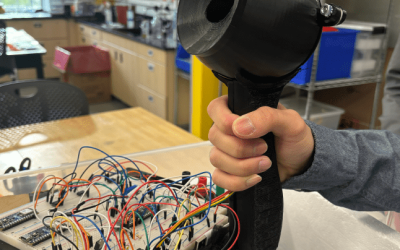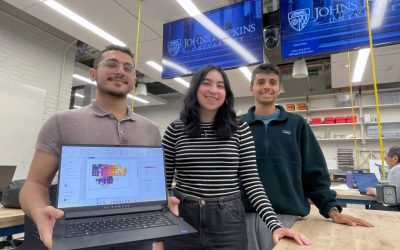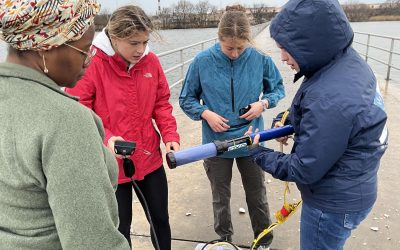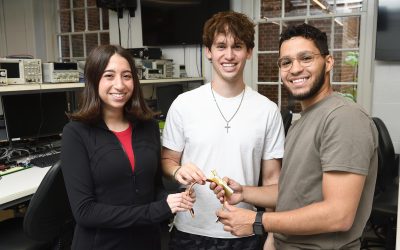News
The Future of Hygiene Products: Biofide’s Biodegradable Incontinence Pads
Department of Chemical and Biomolecular Engineering Design Day team creates a biodegradable pad. By Emily Flinchum One in four women experience some form of urinary incontinence when walking, sneezing, laughing, or jumping, leading many to use disposable incontinence...
OcuSound: An affordable, non-contact solution for monitoring glaucoma
An estimated 80 million people around the world suffer from glaucoma, a group of chronic, progressive eye diseases caused by damage to the optic nerve often due to excessive fluid buildup in the eye. Glaucoma is a leading cause of irreversible blindness, especially in...
Civil and Systems Engineering Students Develop Theoretical Redesign of Baltimore Museum of Art’s Antioch Court
Design Day project embark on reimaging of historic Antioch Court at the Baltimore Museum of Art. By Danielle McKenna For their senior design project, teams of Civil and Systems engineering students are reimagining the Baltimore Museum of Art’s (BMA) historic Antioch...
Student Engineers Flex Their Mussels to Fight Nutrient Pollution
A team of Johns Hopkins undergraduates partnered with Baltimore City to clean up Back River and the Patapsco the natural way By Danielle Underferth A team of Johns Hopkins University seniors studying environmental health and engineering worked with the City...
Johns Hopkins Student Design Sparks Hope for Migraine Relief
Electrical engineering students are developing a device targeting the root cause of chronic headaches By Dino Lencioni A team of undergraduate engineers at Johns Hopkins University is working on a noninvasive, wearable, and reusable device that combats migraine...
Hot or not: A new device for treating temperature-related emergencies
Emergency Medical Services (EMS) providers rely on an array of life-supporting interventions to provide on-the-spot care to patients. Yet they lack a way to accurately measure a patient’s core body temperature (CBT), or the temperature of the body’s internal organs,...
Grounding COVID-19’s Flight Plan: Students Simulate Viral Spread in Airports
By Jaimie Patterson COVID-19 is thought to have spread to the U.S. from travelers on commercial flights. That’s why two Johns Hopkins computer science students have developed a new, ultra-realistic simulation to illustrate the rapid spread of airborne viruses like...
Easy EKG For a Chimpanzee
Engineering students design monkey bar to monitor primates' heart health for Maryland Zoo By Jonathan Deutschman Chimpanzees suffer from the same kinds of heart ailments as humans, and routine EKGs are an important tool used by primatologists to keep the animals'...
Lost in the Sauce: Biodegradable Condiment Packets Combat Landfill Waste
By Emily Flinchum A Johns Hopkins chemical and biomolecular engineering student design team, Lost in the Sauce, has created a prototype of a biodegradable condiment packet that can easily be recycled and could help eliminate the waste generated by today’s ubiquitous...
Parkinetics: Better Monitoring of Parkinson’s Disease Patients at Home
By Holly Paesch A student team in the Department of Biomedical Engineering has developed a signal processing algorithm that they hope will someday help clinicians understand how well medication is working for patients with Parkinson’s, a neurodegenerative disease that...
Students Shine Light on Stockton Street
1386 N. Stockton St, an open lot from the demolition of five rowhouses, has fallen into disrepair. “Light on Stockton Street” is crafted based on the path of the sun, leading the team to include raised beds to grow food and beautify the area in the sun, gathering...
The Turning Point for Better Traffic Light Cycles
By Salena Fitzgerald Ryan Jasper, a junior in the Department of Applied Mathematics and Statistics, has created a modeling technique that could help traffic engineers better adjust the timing and operations of left-turn signals at intersections, potentially improving...














